James Sidney Edouard, Baron Ensor was a Belgian painter and printmaker. He influenced Expressionism and Surrealism, and he lived in Ostend for most of his life. He was associated with the Les XX art group.
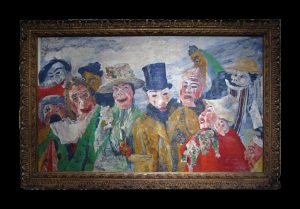
Image source: https://search.creativecommons.org/photos/74ab797f-873e-443f-b830-98549bad856f by Martin Beek
James Ensor was fascinated by the popular carnival culture every year throughout Belgium, around the celebration of Mardi Gras, certainly influenced by the fact that his family’s shop in Ostend was a major supplier of carnival accessories. The imagery he produced is constantly cynical and mocking; presents an almost grotesque form of Realism intended to record the stresses underlying the contemporary social moray eels of his time, and probably of all time.
Early life and education
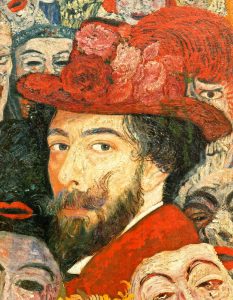
Image source: https://search.creativecommons.org/photos/b1d34e72-1a65-4796-80d8-2611d6af7da8 by Cea.
James Sidney Ensor was born in 1860 in Belgium. His father James Frederic Ensor and his mother Maria Catherina Haegheman owned a carnival souvenir and costume jewelry shop by the sea in the tourist town of Ostend. The shop has inspired Ensor throughout his artistic career. He had a happy and carefree upbringing, living with his mother, father, sister, and aunt. He attended College Notre-Dame, however showing little interest in learning. He struggled within the structured disciplinary environment and dropped out of school after two years.
Style and innovation
Ensor developed a more personal revolutionary method of painting, he began to build volume with spots of color on the surface of the canvas, abandoning the use of illusionism and one-point perspective to organize the depicted image. The effect was imagery that threatened to enter the spectator’s space. The figures in Ensor’s work are crowded to the point of bursting, with no space to breathe, striking for their presence.
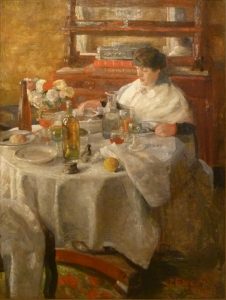
Image source: https://en.wikipedia.org/wiki/The_Oyster_Eater_(Ensor)
The Carnival theme
The artist was particularly intrigued by the carnival theme and found it an excellent means by which to capture society’s foibles. He masked his figures, giving them faces that would express their inner selves rather than their outer, anatomical ones. In this way, he was able to dig beneath the surface and reveal the “true face” of society. His exploration of society unmasked eventually caused his rejection by many, even the local avant-garde artists.
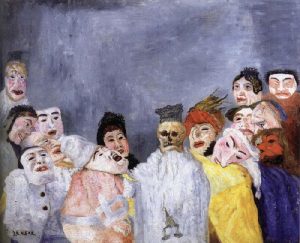
Image source: https://en.wikipedia.org/wiki/File:James_Ensor,_Le_grand_juge,_1898.jpg
Printing and etchings
Ensor was a prolific and printmaker and made 133 etchings and drypoints throughout his career, including 86 of made between 1886 and 1891 during the height of Ensor’s most creative period.
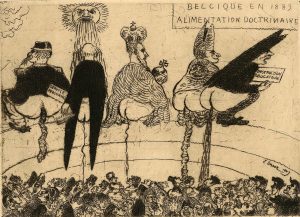
In 1889, Ensor created two highly political etchings. The first, entitled Doctrinal Nourishment, depicts key figures in Belgium—a bishop, the king, etc.—who defecate on the masses of Belgium. The second, titled Belgium in the XIXth Century or King Dindon, depicts King Leopold II watching as military figures violently suppress a protest. Ensor attempted to remove these prints from circulation after being named Baron, so they are not very rare, and many more were lost during the war.
Info sources: http://jamesensor.vlaamsekunstcollectie.be/en/biography https://en.wikipedia.org/wiki/James_Ensor https://www.theartstory.org/artist/ensor-james/ https://www.theguardian.com/artanddesign/
